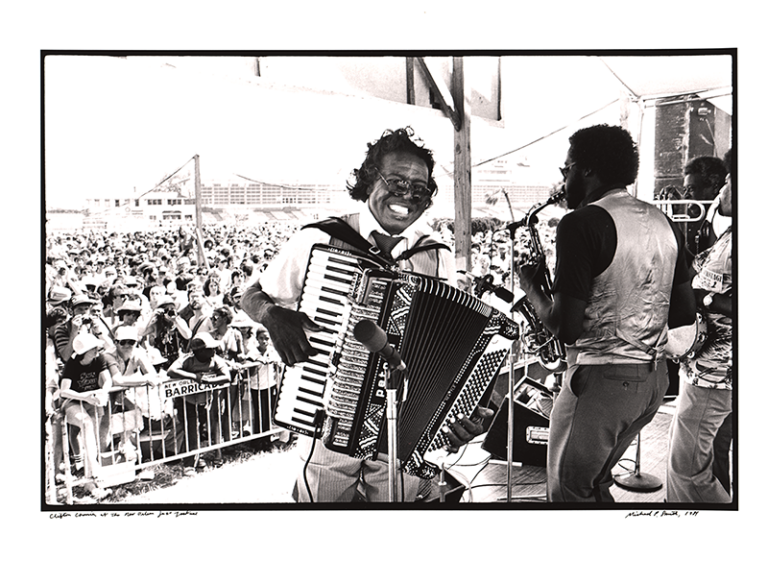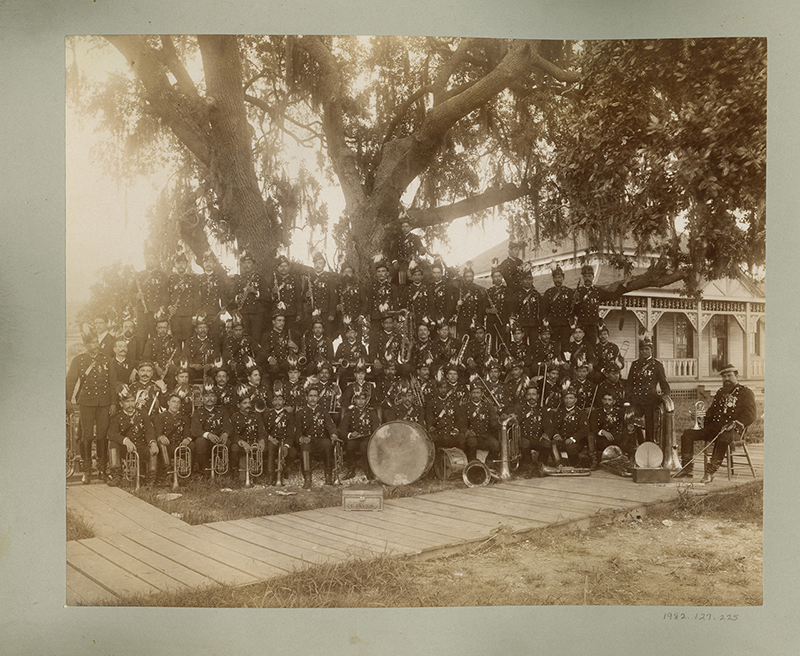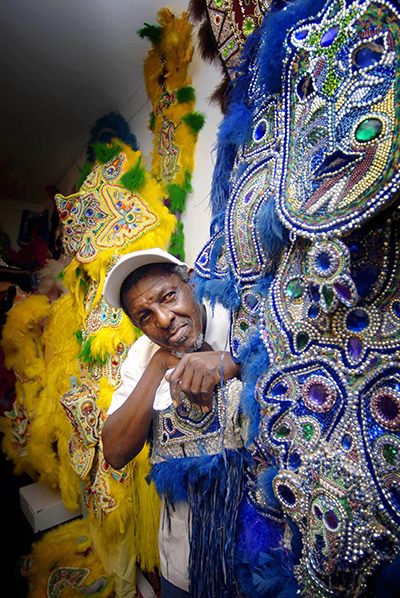SYLVESTER “HAWK” FRANCIS HALL
The air-conditioned grandstand gives Festivalgoers a chance to take an intimate look at the vibrant culture and art of Louisiana. Spanning both weekends on the west wing of the first floor, this year’s special exhibits include The King at 100: Clifton Chenier presented by New Orleans Jazz Museum, Mexican Special by Josh Kun, and Backstreet Cultural Museum: A Powerhouse of Knowledge.
New Orleans Jazz Museum Presents The King at 100: Clifton Chenier
Step into the world of Clifton Chenier, the legendary King of Zydeco, whose musical genius transcended description. A French-speaking Afro-Creole hailing from Western Louisiana, Chenier captivated audiences with his ability to weave together blues and French melodies into electrifying performances that could last four hours without pause. Born just outside Opelousas, Louisiana, Chenier’s early life was steeped in music, influenced by family musicians playing Creole “la-la”. Inspired by the sounds of Amedee Ardoin, Sidney Babineaux, and the jump blues of Louis Jordan, he picked up the accordion while his brother embraced the washboard, and together they began performing at local dances in the 1940s. Though he initially worked in the refinery industry, a job loss in the 1950s propelled him to begin playing the chitlin circuit along the Gulf Coast, where he carved out his unique sound. Alongside his brother, he innovated the frottoir, enlisting a metalsmith to bring their vision to life. Chenier’s recording career ignited in 1954, and by 1955, he celebrated his first hit with “Ay Tete Fee.” His music was rhythmic and powerful combining blues, jump, French songs, and rhythm and blues. After signing with Arhoolie in 1964, Chenier’s career soared. He became renowned for his dynamic performances with the Red Hot Louisiana Band, featuring his brother Cleveland, saxophonist John Ford, and guitarists Sonny Landreth and Paul “Lil Buck” Senegal. His stamina was legendary, as he would enthrall audiences for hours on end. In recognition of his immense contributions to music, Chenier was awarded a National Heritage Fellowship in 1984, and his poignant recording “I’m Here” earned a Grammy in 1983. Sadly, he passed away in December 1987 due to diabetes-related kidney disease. This exhibit celebrates Chenier’s extraordinary life and legacy through a captivating collection of photographs and artifacts, including his accordion, stage attire, and his King of Zydeco crown. Join us in honoring this remarkable artist whose music continues to resonate and inspire.

Mexican Special
Presented by Josh Kun

Taking its title from the Rebirth Brass Band’s 1989 song “Mexican Special,” this exhibition explores the history of musical exchanges between Mexico and New Orleans from the 19th century to the present day. To bring this “special” relationship to life, we will start with some of the earliest known accounts of New Orleans musicians in Mexico in the 19th and early 20th century, from the Tio family to Jelly Roll Morton who spent time in Tijuana, Mexico in the 1920s, writing songs like “The Pearls” and “Kansas City Blues” as tributes to his summers south of the border. The exhibition will also focus on the presence of Mexican musicians in New Orleans, most notably the arrival of the 8th Cavalry Mexican Military Band for the 1884 World’s Industrial and Cotton Centennial Exposition. A massive 76-member operation, “The Mexican Band” and its music seeped into the local repertoires of New Orleans and the catalogs of local sheet music publishers like Junius Hart. They were joined by other Mexican ensembles like La Orquesta Tipica Mexicana, which included the Mexican musician and composer Juventino Rosas, author of “Sobre la Olas,” or “Over the Waves,” which became a staple of New Orleans brass bands. Many claim that it was one of the Mexican Band’s members, Florencio Ramos, who introduced the saxophone to New Orleans. The exhibition will follow these histories up to the present, from Louis Armstrong’s “Mexican Swing” and his performance in Mexico City in 1961 to Preservation Hall’s 1968 Mexico City concert. We will also showcase the many compositions by Fats Domino and Dave Bartholomew that were covered throughout the 50s and 60s– often in Spanish– by Mexican and Mexican-American bands, including Los Apson, Manolo Muñoz, Los Teen Tops, and Little Joe and the Latinaires. We will feature Mexico City’s La Tropa Loca singing about The Battle of New Orleans, Chamaco Dominguez doing his version of a New Orleans mambo, and contemporary songs of New Orleans bands like the Mexican Zydeco Band and Los Guiros. Not to mention the long list of Mexican and Mexican-American acts who have played the stages of Jazz Fest for decades. Mexican Special will consist of a dynamic mix of photography, archival ephemera, sheet music, record and CD art, and listening stations featuring an exclusive Mexico-New Orleans playlist for visitors to spend time with.
BACKSTREET CULTURAL MUSEUM:
A POWERHOUSE OF KNOWLEDGE
For three decades, culture bearer and historian Sylvester Francis held court in the Grandstand at Jazz Fest, sharing his life’s work with Festivalgoers. The founder and director of Backstreet Cultural Museum, Francis would build an exhibit of meticulously curated Jazz Funeral photography & memorabilia, Social Aid & Pleasure Club crafts and cherished second line mementos. Always included were his rare recorded film footage of New Orleans’ funerals, second lines, Baby Dolls, Skull and Bone Gang and Black Masking Indians. Continuing his life’s work, daughter Dominique Dilling Francis upholds his legacy, exhibiting collections of photos and video recordings, as well as second line mementos from the Backstreet Cultural Museum which she continues to run in the heart of Treme.





